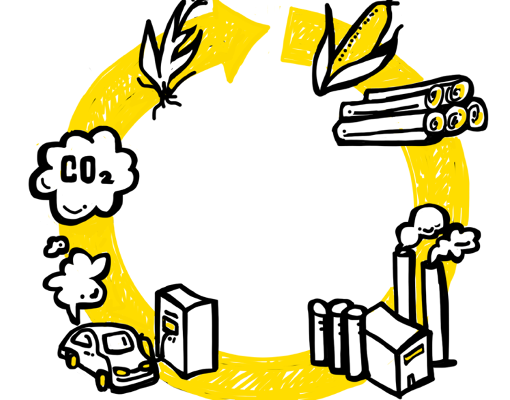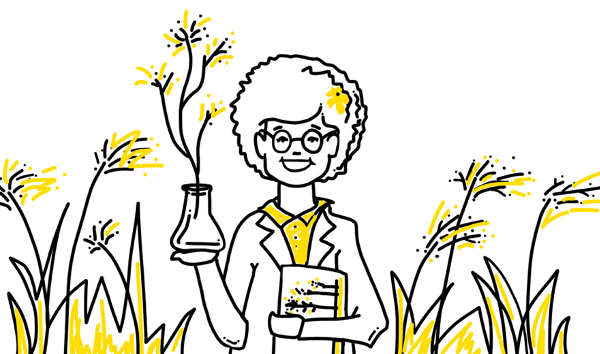An Everyday DNA blog article
By: Sarah Sharman, PhD, Science writer
A lot of fuel is required to keep our country running. Americans consume an average of 390 million gallons of motor gasoline and 197 million gallons of aviation gasoline, per day, to fuel planes, trains, and automobiles. Most of the fuel that we currently consume is fossil fuel formed from the fossilized, buried remains of plants and animals that lived millions of years ago. One such fossil fuel, petroleum, is refined into other fuels, such as diesel and gasoline.
Because of their origins, fossil fuels have a high carbon content, meaning they produce a lot of energy when they are burned. However, burning fossil fuels can have negative impacts on our environment through air and water pollution and the release of carbon dioxide, a known greenhouse gas thought to contribute to global warming. Another limitation of fossil fuel is that they are an exhaustible resource that will eventually run out. Our growing fuel needs compounded with the risks and limitations of fossil fuels have led to a renewable energy movement aimed at reducing the production and use of fossil fuels in favor of cleaner, more sustainable fuel sources.
What is biofuel?
 Biofuels are promising substitutes for fossil fuels that are produced from renewable, organic (carbon-containing) materials like plant matter and animal waste. These materials, termed biomass, include agricultural crops and agricultural waste, algae, dedicated energy crops, and forestry residues. Common crop plants that are used as biomass include sugar crops like sugarcane, starch crops like corn and sorghum, oilseed crops like soybean and canola, and cellulosic plants like corn stalks, grasses, and waste wood chips.
Biofuels are promising substitutes for fossil fuels that are produced from renewable, organic (carbon-containing) materials like plant matter and animal waste. These materials, termed biomass, include agricultural crops and agricultural waste, algae, dedicated energy crops, and forestry residues. Common crop plants that are used as biomass include sugar crops like sugarcane, starch crops like corn and sorghum, oilseed crops like soybean and canola, and cellulosic plants like corn stalks, grasses, and waste wood chips.
Today, most biofuels are produced from agricultural crops and are called conventional, or first-generation, biofuels. New technologies and processes that produce fuels from waste, inedible crops or forestry products are being developed and these fuels are known as advanced, or second-generation biofuels. Because advanced biofuels use waste products, leftover plant scraps and non-food crops, they do not take crops and land away from the food supply industry. This could help improve sustainability, making advanced biofuels a promising form of fuel for the future.
How are plants turned into fuel?
The walls of plant cells are made up of three molecules: cellulose, hemicellulose, and lignin. The cellulose and hemicellulose are filled with sugar building blocks that can be used as an energy source. However, the lignin is a fibrous molecule that binds all of the molecules together in a compact structure, giving the plant the structural support needed to survive. In order to access the sugars to make biofuel, the fibrous lignin must be broken apart. 
The process of turning plants into fuel begins with a deconstruction step in which the plant cell wall is broken apart. This can be achieved using high heat and pressure, or through the use of biological catalysts called enzymes. The deconstruction step breaks the plant material down into chemical intermediates such as crude bio-oils, sugars, gaseous intermediates, and other chemical building blocks. The intermediates cannot be used directly for biofuel so they must be upgraded into finished products using biological or chemical processing. The finished products from upgrading may be fuels or bioproducts ready to sell into the commercial market, or stabilized intermediates that can be sent to a petroleum refinery or chemical manufacturing plant.
What is biofuel used for?
 The use of biofuels has grown over the past decade, driven largely by the introduction of new energy policies in several countries, including the United States, that call for more renewable, lower-carbon fuels for transport. Since biofuels emit less carbon dioxide than conventional fuels they can be blended with existing fuels as an effective way of reducing carbon dioxide emissions in transportation. The two most common types of biofuels in use today are ethanol and biodiesel.
The use of biofuels has grown over the past decade, driven largely by the introduction of new energy policies in several countries, including the United States, that call for more renewable, lower-carbon fuels for transport. Since biofuels emit less carbon dioxide than conventional fuels they can be blended with existing fuels as an effective way of reducing carbon dioxide emissions in transportation. The two most common types of biofuels in use today are ethanol and biodiesel.
Ethanol is produced by fermenting sugar or starch in a process similar to fermenting beer. It is blended with gasoline, either at low levels in regular vehicles or at higher levels in cars that have been adapted to take both gasoline and ethanol, known as flexible-fuel vehicles. Nearly all of the gasoline sold in the United States today contains about ten percent ethanol by volume.
Biodiesel, for use in diesel engines, is produced using oil from raw vegetable oils, used cooking oils, yellow grease, and animal fats. It is most often blended with petroleum-based diesel at low-ratios. However, biodiesel can also be used as a heating oil.
How are scientists contributing to the biofuel field?
 Although interest in biofuels is growing, they only represent around three percent of road transport fuels in use around the world today. There are several reasons that the use of biofuels does not match the heightened interest in biofuel. For example, the process of growing the crops, making fertilizers and pesticides, harvesting the crops, and processing the plants into fuel consumes a lot of energy that some argue offsets the benefits of biofuel. Some also argue that diverting crops like corn from the food supply to energy use is detrimental to the economy.
Although interest in biofuels is growing, they only represent around three percent of road transport fuels in use around the world today. There are several reasons that the use of biofuels does not match the heightened interest in biofuel. For example, the process of growing the crops, making fertilizers and pesticides, harvesting the crops, and processing the plants into fuel consumes a lot of energy that some argue offsets the benefits of biofuel. Some also argue that diverting crops like corn from the food supply to energy use is detrimental to the economy.
To solve these problems, scientists like HudsonAlpha Faculty Investigator Kankshita Swaminathan, PhD, are exploring other materials that have the potential to serve as biofuel crops without the accompanying concerns over food supply and environmental impact. Engineering biofuel crops that can grow on land that is unsuitable for food production and require less energy and pesticides/fertilizers to grow would ensure that the payoff from biofuels outweighs the resources needed to produce them.
Swaminathan’s lab aims to improve cellulosic bioenergy crops like the perennial grasses Miscanthus and switchgrass. By combining basic biology with genomics and genetics, the group is working to understand the biology behind these crops in hopes to identify genes that will help increase their yields and improve their abilities to adapt to extreme environments such as poor soils and drought. To hear Dr. Swaminathan talk more about her research, watch this episode of Genomics and Java.


